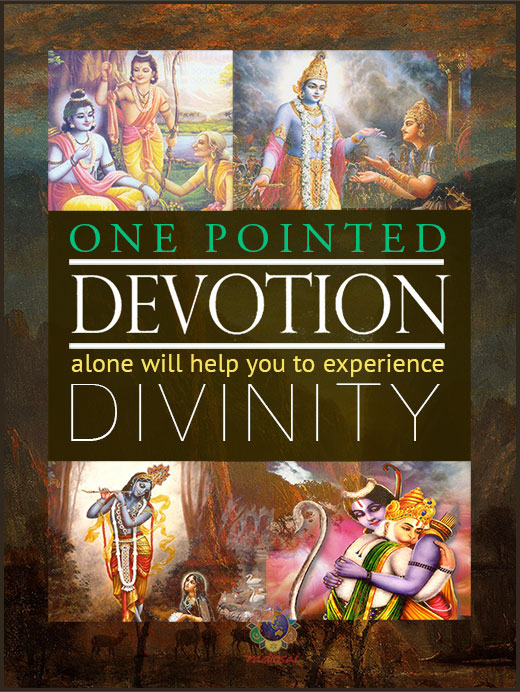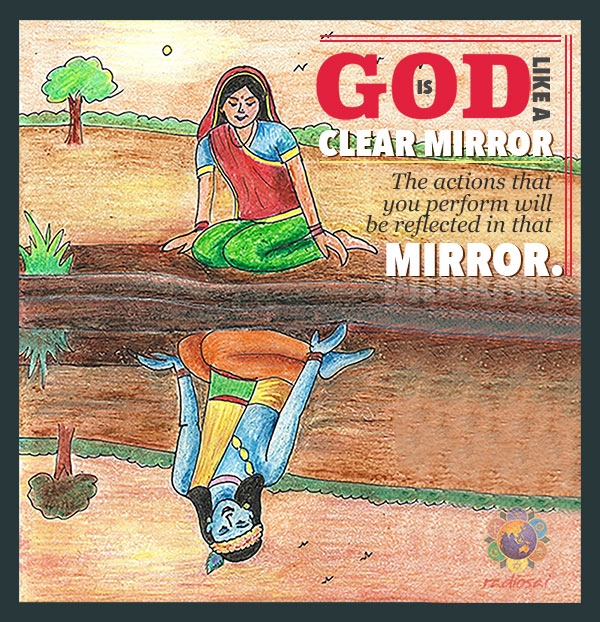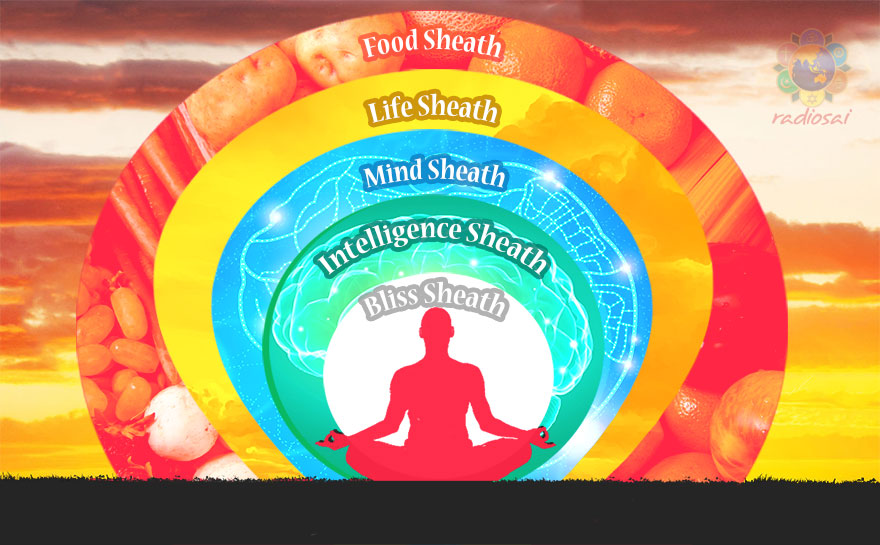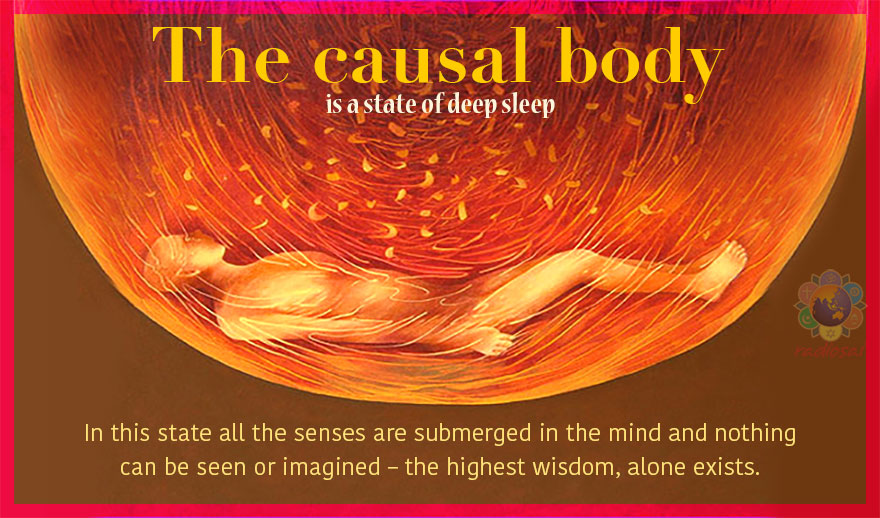|
|
| 'Like' us on Facebook | Follow us: |
Posted on: May 14, 2016
SATHYA SAI BABA ON
THE STHULA (GROSS), SUKSHMA (SUBTLE)
AND KARANA (CAUSAL) WORLDS
Part 03
by Ms. Christan Mackenzie
Gold Coast, Australia
Distinguishing External Appearances
We need to distinguish the uniquely individual and private experience of sukshma-sarira from the visions or apparitions of God which may rarely occur for some people in the waking state. Baba says categorically that in all cases such experiences are generated by man’s own mind. When they are not mere hallucinations, waking visions and manifestations of forms of God, arise from within man’s heart. Man, through his intense focus or devotion, may bring about the conditions for God to appear in the objective world.
 |
To experience Divinity (Atma) in this way Ekantha-Bhakthi (one pointed devotion) alone will help you. On any other path you may experience visions of different types. These are nothing but hallucinations and products of imagination. Without virtuous qualities, you cannot control your mind. How can you build a house without brick and mortar? To achieve purity and steadiness of mind, earnest practice is essential. Ekantha-Bhakthi is not obtained by locking yourself in a room and worshipping an idol with devotion. This can only be called Ekaki-Bhakthi; after all, the idol is only a created object. You should experience your Atma-Swarupa and not a created object. You should have a vision of the Primordial Divinity, whose reflection is your Atma. Worshipping an idol is necessary as a first step. But do not devote all your lifetime on the first step!
(Divine Discourse, 23 Jan 1982, Madras)
You say that Rama or Krishna or Sai Baba, etc. have appeared before you. Several people make such claims. These are all figments of one's illusion (bhrama). As long as you have bhrama you will be far away from Brahma (Divinity). On the other hand if you have realised Brahma, bhrama can come nowhere near you. The need of the hour is therefore to overcome this illusion. Get rid of the body attachment. Cultivate attachment to the Atma instead. Your true identity is Atma. It has neither a name nor a form. It is the embodiment of bliss.
(Summer Showers in Brindavan, 2002, page 74)
Bhagawan does not qualify this statement with ‘some are real’; He says, ALL are imagination. Remember, this is the universe of Maya, in which all forms are imagined!
Imagination is called the faculty of imagining. It is the ability to form new images and sensations in the mind, hence the term, ‘the mind’s-eye’. Imagination is thought turned inward and helps make knowledge applicable to solving problems. It is fundamental to integrating experience and the learning process.
Bhagawan talks about the great power of thought. He says that, ‘thought waves make up the cosmos’.
The mind is extremely powerful. It runs at great speed. It is subtler than the sky and even more subtler than electricity. The mind can run faster than light. The mind also operates like radio waves, just as you are able to hear a broadcast of music from a radio station in Delhi, in Whitefield. Thought waves emanating from the mind have also got properties of radio waves. There is no end to the waves arising from the ocean of the mind. The power of thought is immense. Thoughts outlast the human body. Thought waves radiate very much like heat waves, radio waves and light waves. The thought waves are the cause of man's joy or sorrow, health or disease, birth or death. The potency of these waves has to be understood by man and his conduct has to be based on this awareness. The whole cosmos is made up of thought waves; hence, the scripture declares: 'The mind is at the root of the cosmos.' There is no place, or form or action wherein the mind is absent. Hence, all thoughts of man should be turned in the right direction.
 |
(Divine Discourse, 23 May 1993, Brindavan)
So the question is then, if apparitions of Sai Baba, Rama, Krishna and other deities are arising from imagination - but whose imagination is it? From Baba’s teaching (excluding hallucination and misrepresentation) it is about a connection that happens between the intensely focused individual (the force of thought) and God. Such an apparition may be karmic, for example the result of actions done in a past life, and occur to an individual without any apparent reason in this life.
An example of a true apparition of the Lord is told by Bhagawan in the story of Dhruva. Dhruva, a five year old boy was doing severe penance in a forest, in order to win his father’s love. The Lord finally appeared before him due to the intensity of his devotion, which was even burning the forest and alarming the sages.
As the Lord came closer and closer, His effulgence intermingled with Dhruva’s aura and Dhruva shone brighter and brighter. Suddenly, finding his heart empty of the Lord’s Form, Dhruva opened his eyes. He saw the Lord standing in front of him. Smiling, Dhruva said, “O Lord, so long You were in my heart. Now You are outside me. Are You trying to leave me? I won’t allow it.”
Dhruva had recognized that what we see outside is a reflection of our own hearts. If you feel that someone is bad, that bad is not in him, but only a reflection of your heart. Your own thoughts, both good and bad, appear to you outside as reflection, reaction and resound.
Even Lord Narayana was taken aback at Dhruva’s ideal qualities! The Lord mused, “How surprising that these eternal feelings have entered this young boy! He is enjoying the benefits of many past lives spent in the divine quest.”
(Summer Showers in Brindavan, 1995 pp 87-92)
Baba tells how Druva went on to merge in the Anandamaya-kosa (the bliss sheath). A similar lesson is told about Radha and Krishna.
Since Radha had Krishna in her thoughts at all times, Krishna was also thinking of her. Just as by having continuous knowledge of the Brahman, one can hope to become identical with Brahman, so also by constantly thinking of Krishna, Radha wanted to merge in Krishna. If you keep on repeating the word Radha continuously, it becomes Dhara and similarly if you keep on saying Radha Krishna continuously it becomes Krishna-Radha. Therefore, Radha may be transformed into Krishna and Krishna may be transformed into Radha. The nature of God is such that the thoughts with which we think of Him and the ideas that we ascribe to Him will determine the kind of response that He will give.
God is like a clean, clear mirror. The actions that you perform will be reflected in that mirror. Radha said, “Krishna! Will anyone want to see the image, if the original itself is available to him? Will the beauty of an object be fully reflected in its image? Out of milk which has been broken, can we get curds?”
While Radha was thinking of Krishna in this manner, Krishna’s divinity also came out in a bright and effulgent form. When this took a separate form, it left Krishna and began moving forward. In order to get back His brightness, Krishna was physically following the effulgence. Gradually, this effulgence came and merged in Radha.
In the context of this Jyothi coming and merging in Radha, she was also described as Ahladini - a name that signifies Ananda. Since this bliss came out of Krishna and merged in Radha, Krishna had to come to Radha for receiving back His effulgence.
 |
|
| Painting Courtesy: Vidhi S. Bhojwani, India |
(Summer Showers in Brindavan 1978, pp 163-168)
These discourses show how the power of thought, intensity of focus result in reflecting the Inner Divine outwardly, and this power can build and travel across lifetimes!
Does the Sukshma-Sarira Manifest in the Waking State?
The subtle world (of higher wisdom and its opposites) is experienced in the waking state through the twenty-five instruments of the sthula. We have learnt that in the waking state, man in called Viswa. In the sthula-sarira (physical body in the waking state), the subtle world is experienced as emotion, feeling and wisdom, with the added ability to act upon these in the physical world through the organs of bodily action.
The sukshma-sarira or the ‘dream body’ which lacks the organs of action, is illumined by the mind and the Tejas, the inner light, and so it is called Tejas (light). The Divine Principle in the dream state is referred to as Taijasa. Taijasa is Atma. Baba teaches that the sukshma-sarira, the dream or ‘light body’ lit by the Atma, is unique to the individual concerned, is private to them and it functions in the dream state.
There is no suggestion that the appearances of God to Radha and Druva were the sukshma-sarira of the Lord, and one needs to be careful about making such deductions about very specific terms such as this. It is not suggested in Baba’s discourses that Radha and Druva were dreaming! Simply, the term sukshma-sarira is not the correct application for apparitions of God in the physical world.
Does the Sukshma-Sarira Survive Death?
In conversations with John Hislop, Sai Baba answered this question directly (He also points out that the subtle body doesn’t have body-senses).
Hislop: When I am absent from Baba's physical person and far away in America, I know of His actual Presence by the jasmine perfume. Someone said it was smelled by the smell-sense of the subtle body, is this correct?
Sai: No. Senses are in the physical body. Subtle body does not have senses. The perfume is known by the physical senses.
Hislop: Does man have three bodies?
Sai: Yes. Body, Mind and Soul. Physical body, subtle body and causal body. On death, the physical and subtle bodies disintegrate, but the causal body remains.
Hislop: How about the five kosas, the five sheaths?
Sai: The food sheath, life sheath and mind sheath are impermanent. The intelligence sheath and bliss sheath remain. The body is mud. Out of the mud everything grows. Only the body dies. Life and all the senses merge into mind. Mind merges into wisdom. Wisdom merges into bliss, into God. Thus there are five sheaths.
(Conversations with Sai, Part 18)
The Life Sheath (pranamaya kosa) and with it the vital airs (digestive, circulating, upward moving, life-breath, downward moving) which circulate in the living physical body, disintegrates or is destroyed on death. It is the end of the sukshma-sarira as it is known and defined by Baba, because this ‘dream body’ is the function of the three kosas associated with Atma in the living body of man.
Baba also says that after death we may experience some of the fourteen heavens or hells, which are all in the body of people (as karmas). (Prasnothara Vahini)
In ‘Conversations with John Hislop’ He describes these ‘places’ as thought.
 |
The merging of the kosas and the existence of heavens and hells after death suggests that the disintegration of the manomaya-kosa (the mental sheath) is gradual after death, because there must be a ‘cogniser’ for ‘mental stuff’ that is eventually played out or subsumed into the karana (causal).
There is some confusion by writers concerning a statement of Baba’s regarding the Emperor Bali who is said to return annually in his sukshma-rupa to visit devotees. This is sometimes quoted and used to support an argument of precedence for such ‘returns’.
Bali was an embodiment of tyaga (renunciation) and he personified the aspects of dhathru tatwam (principle of charity) and dharma tatwam (righteousness). Since Onam is a festival day to be celebrated in memory of the reappearance of Bali in his sukshma-rupa (microscopic subtle form), it is imperative for everyone to remember and practise the ideals for which he stood when he was alive.
(Divine Discourse, 4 Sep 1979, Brindavan)
Being a sukshma-rupa - such a ‘form’ could not be seen by anyone at any level of waking consciousness. Sai Baba’s statement may refer to people dreaming of Bali and sensing ‘presence’, since the form is described as ‘microscopic’ and could not be actually seen. A more understandable view of Bali is provided by Sai Baba when He refers to the ‘belief’ of Keralites that Bali comes back to bless the region once a year. He refers to the faith and devotion of these people, and from what we have learned about Radha/Krishna and Druva and the Lord, we can better understand any apparitions as arising from the Atmic hearts of intensely devoted people with their special inner connection with the Divine.
The Bhagavata Purana declares that he was consigned to Suthala, the most sacred of the nether regions. In other words, Bali was blessed with an inner vision of the Lord in his heart. The Lord assured him that He would grant him His constant presence in the Suthala region. The Message of Onam is that the Lord is won by means of total surrender of the ego. When the heart is pure, the Lord resides therein and guides man to Himself.
(Divine Discourse, 07/09/1984)
Bali merged with the Lord, and thus the constant presence of the Lord in that region can be best understood.
Karana (Causal)
Karana, the shrine (Garbhagriha), is associated with suvaha, spirit. It reflects Atma and pertains to the spiritual world, and means causal and its quality is radiation.
The karana-sarira (the causal body) is related to the deep sleep state. In this state all the senses are submerged in the mind and nothing can be seen or imagined – prajna, the highest wisdom, alone exists. Karana is also called, ‘Constant Integrated Awareness’.
In deep sleep, all the impulses (vasanas) are suspended; though they still persist, they are not manifest or active. In the causal body, the subconscious mind (chitta) is in association with the knower, the knowing principle (jnatha).
The karana-sarira has only two instruments – the Will and Constant Integrated Awareness. It has no vital airs, no subtle elements, no bodily organs and no elements.
 |
It has one sheath, the anandamaya kosa, the sheath of Bliss. Even this sheath must be peeled away, as man reaches back to know and experience his pristine, Divine state, which is beyond the kosas.
The karana-sarira is the only body of man that categorically survives death of the sthula-sarira and the disintegration of the sukshma-sarira. The anandamaya kosa (bliss sheath) and the vignanamaya (the discriminatory power, the intelligence sheath) remain – but the other three kosas that form the body and mind (Annamaya, pranamaya and manomaya) do not.
Where the sukshma-sarira may be understood as the experiencer of karmas, and the sthula-sarira is the action body where karmas are played out on the physical plane, the karana-sarira is wisdom and knowing, beyond the mind. It can be likened to a storehouse, where things are kept for later distribution (later life play or new incarnation).
Mahakarana (Super Causal)
Beyond all these bodies or aspects of creation is the Mahakarana, known as the Super-Causal. Its state of consciousness is Turiya, complete ineffable Bliss in which the Universal Consciousness alone is experienced. It is beyond description, beyond both intellect (buddhi) and mind (manas). The experience is inadequately described as peace, grace, and oneness (santam, sivam, adwaitam); that is all. The mental agitations are stilled, so there is no more mind. It is the conquest of the mind, its negation, the mindless stage.
The Mahakarana is the pure consciousness unmixed with any or elemental principle (tatwa), the witness eternal, the Self-luminous. It is referred to as the Supreme Cause. It is also known as Cosmic Intelligence (Hiranyagarbha). Because it is stateless (beyond states of consciousness) it is described as the Imperishable (Akshara-purusha).
Radio Sai Team
What do you think about this Article? Please let us know by writing in to h2h@radiosai.org or you may leave your thoughts in the comments section. Do not forget to mention your name and country.
| comments powered by Disqus |






